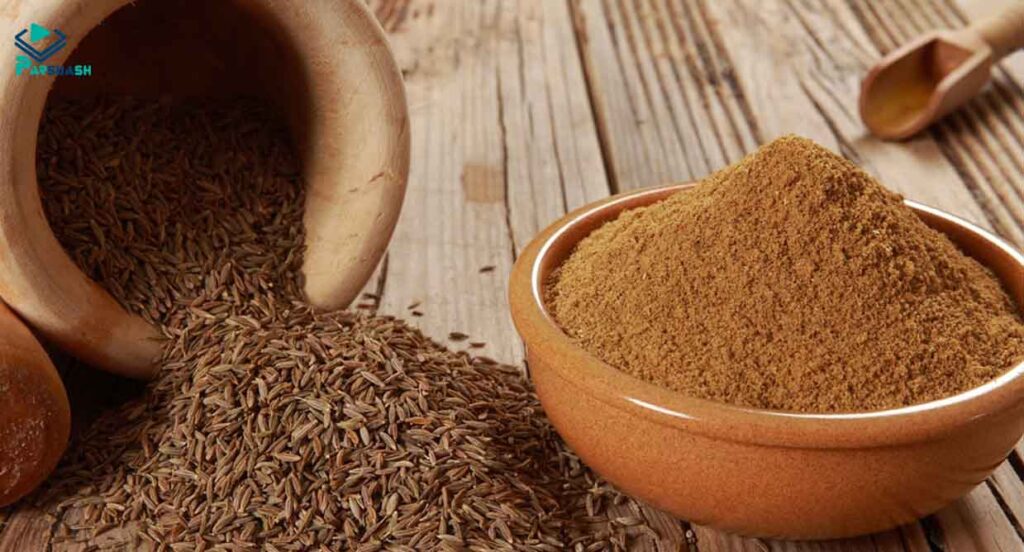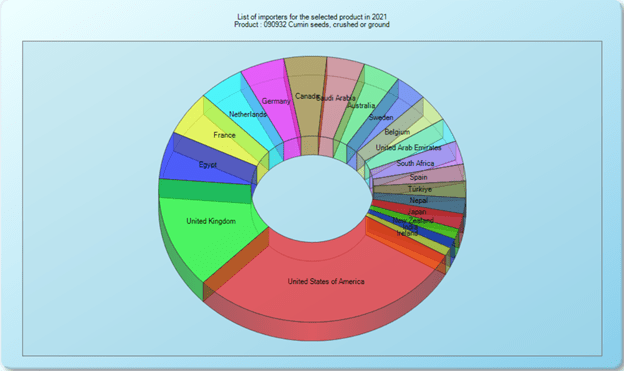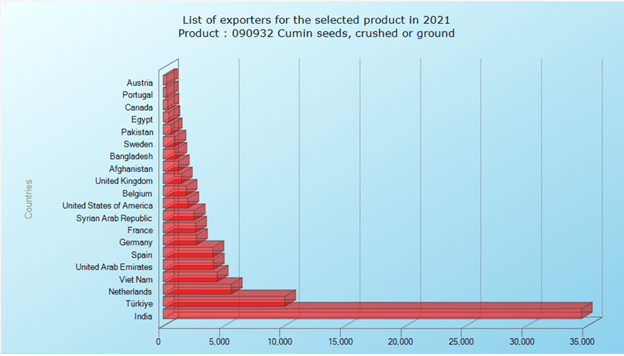
Table of Contents
Iran has unique weather conditions among the countries of the world. In other words: Throughout Iran, there are almost all climatic zones in the world. The climatic diversity and different geographical conditions such as forests, deserts and mountains have resulted in a wide variety of plant species used for food, medicinal purposes and industry. There are about 8000 plant species in Iran, of which more than 2300 species have medicinal, hygienic and cosmetic properties. Cumin is one of the ancient and indigenous medicinal plants in Iran. After saffron, cumin is the second most important export crop in terms of value of Iranian rial and the second most important spice crop in the world after black pepper.
Characteristics of cumin
Cumin is known by several names in several languages, including kū míng (Chinese), jeera (Hindi), cumino (Italian), comino (Spanish), cumin (French), kamoun (Arabic), and Kreuzkuemmel (German).
.
Cumin is a plant of the parsley family (Apiaceae). It is a small annual herb with a height of 15-50 cm. The root is narrow and long, the stem is straight, the leaves are transparent, hairless and have the shape of thin, delicate, long and thread-like cuts. The flowers are small, white or pink and are in umbels. The fruit is a 6 mm long, lateral, conical or ovoid nut. The color of the fruit varies depending on the species. Some are brown (black cumin), others white (cumin). Its Latin name is (CUMIN) and its scientific name is (L. Cuminum cyminum). Originally, cumin originated in northern Egypt and the Nile region, but today it is cultivated in much of the Mediterranean region, India, Iran, Arabia, etc. India is the largest consumer of cumin in the world. Since the plant is native to the Mediterranean region, it needs light and heat to grow. Cumin is known in the world by the international code (HS code) 090932.
.
Cumin nutritional information and health benefits
Cumin has many benefits. Cumin is rich in fiber, which naturally stimulates the digestive system, improves digestion and treats hemorrhoids. The plant is a rich source of vitamins A, E, K, and C, niacin, thiamine, choline and folic acid. It also contains minerals such as calcium, iron, magnesium, phosphorus, potassium, sodium, zinc, manganese and selenium. The essential oils cumin aldehyde and pyrazines in jeera act as a natural laxative, help heal infections or wounds in the excretory system, and relieve hemorrhoids. Cumin helps reduce weight, cholesterol, sugar in diabetics and stress. It helps to strengthen the immune system. It improves the respiratory system, eliminates anemia and is good for the liver. Cumin is the main ingredient of curry and chili spices. Cumin is one of the most commonly used spices in vegetarian and non-vegetarian preparations. Its powder is used to flavor soups and stews and to flavor meats. The compound may prevent cognitive impairment and Alzheimer’s disease. From steam distillation, is used in desserts, flavored drinks and spices. It is also used in creams, perfumes and lotions.
.

Cultivation and care of cumin
Cumin has been cultivated and used as a spice since ancient times. It was originally cultivated in Iran and the Mediterranean region. It was also known in ancient Morocco and Rome. In the middle Ages, cumin fell out of favor in Europe except in Spain and Malta, but is more commonly used again today; it was introduced to the Americas by Spanish colonists. Today it is grown mainly in Iran, Uzbekistan, Tajikistan, Turkey, Morocco, Egypt, India, Syria, Mexico and Chile.
.
Temperature requirements: It does well in moderately dry and cooler climates; subtropical climates are ideal for growing cumin. At low temperatures, leaf color changes from white to purple. High temperatures can shorten the growing season and cause early ripening. As a result, its quality decreases. Cumin is sensitive to cold, the ideal temperature is 2 to 5 degrees Celsius. Frost damage can be minimized by spraying with a 0.1% sulfuric acid solution.
.
Soil requirements: Cumin does best in fertile, well-drained, sandy loam to clay soil. Heavier soils require amendments such as perlite to improve drainage capacity. Cultivation in light sandy soils, free of nutrients and materials, is not suitable, as such soils are prone to preparing conditions that cause fungal diseases. The suitable PH for growing cumin is 4.5 – 8.2. In addition, the soil should be prepared by plowing and fertilizing before planting.
.
Water requirements: cumin needs less irrigation than other members of this plant family and is resistant in dry, tropical and subtropical areas. Before planting the seeds, the soil must be irrigated. After planting the seeds, watering should be loosened so that the seeds are not washed away, and the next watering is 8 to 10 days later, then the plant sprouts. If the planting area has hot weather, it should be watered again 5-6 days after the second watering. During the flowering and fruiting phase, this plant requires less water and moisture. Depending on the climate of the growing area, the plant needs watering from 12 to 20 days.
Types of cumin
Cumin is grown and produced in two types: white and black. The black type is known by its scientific name (Carum carvi) and its traditional name (Kroya). In Iran, black cumin is known as Kermani cumin, Koohi cumin and Shah cumin. Its white type is known by its scientific name (L. Cuminum cyminum) and in botany by the name (caraway). These two species differ:
.
1-The taste of white cumin is bitterer than that of black cumin, but the taste of black cumin resembles licorice.
2- As for the appearance, the pigments of white cumin are lighter than those of black cumin and its size is larger than that of black cumin. The black cumin is small, crescent-shaped and multi-faceted, similar to anise and fennel.
3- Since they have different scientific names, the plants from which the fruits of white and black cumin are obtained are also different.
4- The life span of black cumin plant is longer than that of white cumin and is two years, while that of cumin is less than one year.
5- Cumin is the main ingredient in the production of masala spices and curry powder, and is often used in the preparation of Mexican and Indian dishes.
6- Black cumin is used in the preparation of German dishes, French toast and all kinds of cookies and cakes. Its powder is also used as a spice in the preparation of home-made sausage.
Global trade in cumin
In 2020, cumin was the 2308th most traded crop in the world with a trade volume of $707 million. In 2020, cumin was the 2308th most traded crop in the world with a trade volume of $707 million. Between 2019 and 2020, cumin exports increased by 12 percent, from $631 million to $707 million. Cumin trade accounts for 0.0042% of total world trade. In 2020, the largest exporters of cumin were India, Syria, Turkey, the United Arab Emirates, and Afghanistan. China, Bangladesh, the United States, the United Arab Emirates, and Turkey were the largest importers of cumin seeds. In 2018, the average tariff rate for white cumin was 11%, ranking 1934th lowest tariff according to the HS6 commodity classification.
.

.
This map shows which countries export or import the most cumin. Each country is colored according to the difference between exports and imports of cumin in 2020. In 2021, the countries that had a greater trade value in exports than imports of cumin were India ($517 million), Syria ($29 million), Afghanistan ($11.2 million), Iran ($8.86 million), and Turkey ($3.96 million). In 2021, the top importers of cumin seeds were China ($168 million), Bangladesh ($72 million), the United States ($48.6 million), Nepal ($22.8 million), and Saudi Arabia ($19.9 million). According to the statistics on the Trade Map website (in 2021), the total import value of this product was $83,015 thousand, and the following countries had the largest import volumes:
.

.

.
According to these statistics, the appropriate markets for the export of cumin are the United States, England, Egypt, France and the Netherlands.
The total export volume of this product in 2021 was 85,215 thousand US dollars, and the following countries had the largest import volumes:
.

.

.
According to these statistics, the largest exporters of this product are India, Turkey, the Netherlands, Vietnam, and the United Arab Emirates.
Cumin Cultivation Areas
India, as the leading producer, has a world market share of 70%, followed by Syria (13%), Turkey (5%), and the UAE (3%). These four countries produce about 91% of the world’s cumin, with the remaining production coming from other tropical or subtropical Asian and African countries.
Cumin exports from Iran to the world
The export of Iranian cumin, both white and black, to the United Arab Emirates and other Persian Gulf countries, especially black cumin, which has a high price, is very prosperous. Black cumin, especially Kermani cumin, is one of the most expensive spices available in the market. Due to the quality of Iranian cumin and the interest of Emirati and Japanese buyers in this product, its price is higher than the price of Indian cumin.
The total value of export of cumin products from Iran to other countries amounted to 21 thousand US dollars in 2021.
.

.
According to these statistics, the largest importers of these Iranian products are Iraq, Canada, America, England, Holland, Germany and France.
In 2019, Iran exported 2,357 tons of cumin seeds. In 2019, the interest in cultivation and export of cumin seeds and spices in Iran increased by 35.928% compared to 2018. Between 2017 and 2019, Iran’s export of cumin increased by 93.67%.
.
Cumin cultivation areas in Iran
Cumin is grown as a wild plant in Iran in the provinces of Khorasan (Sabzevar, Aliabad, Mashhad, Salehabad), East Azerbaijan, Yazd, Semnan (an area called Kish Lak at an altitude of 900 meters, Sorkheh, Damghan), Isfahan, Golestan province (Sahara Turkmen) and Kerman.
Cumin Price
The world price of cumin is primarily determined by those countries that have a greater trade value in exports of cumin seeds than in imports. India is the largest exporter of cumin in the world. The average price for a ton is US$ 2251.27 in Mumbai and New Delhi. In 2023, the approximate price range for Indian food grains is expected to be between US$2.25 and US$2.35 per kilogram. (The price has not changed compared to 2019). In 2019, export market prices of Iranian cumin changed by 53.685% to $4.68 per kilo. In 2023, the approximate price range for Iranian cumin is expected to be between $4.68 and $3.04 per kilogram. The average price for a ton of this product in Mashhad and Tehran is $4,680.1.
Outlook and forecast for the cumin market
The global cumin powder market is expected to grow at a CAGR of 6.5% between 2022 and 2030. The growth of the market can be attributed to the increasing demand for cumin powder in food and medicinal applications. In addition, growing population and rising income levels are also contributing to the growth of the market. Food is the largest application segment and is expected to account for more than two-thirds of the global demand for cumin powder by 2022. Medical is the second largest application segment and is expected to account for more than one-third of the global demand for cumin powder by 2022. Moreover, increasing consumer preference for ethnic spices owing to their health benefits is expected to positively impact regional growth over the next seven years.
